The Control of Shale Composition on the Pore Structure Characteristics of Lacustrine Shales: A Case Study of the Chang 7 Member of the Triassic Yanchang Formation, Ordos Basin, North China
Abstract
1. Introduction
2. Geological Setting
3. Samples and Analytical Methods
3.1. Samples
3.2. Analytical Methods
3.2.1. Vitrinite Reflectance
3.2.2. TOC Content
3.2.3. X-ray Powder Diffraction
3.2.4. SEM Imaging
3.2.5. Low-Pressure N2 and CO2 Adsorption
4. Results
4.1. Organic Matter Content and Thermal Maturity
4.2. Mineralogical Composition
4.3. Pore Structure Characteristics
4.4. Pore Types
5. Discussion
6. Conclusions
Author Contributions
Funding
Conflicts of Interest
References
- Passey, Q.R.; Bohacs, K.M.; Esch, W.L.; Klimentidis, R.; Sinha, S. From oil-prone source rock to gas-producing shale reservoir-geologic and petrophysical characterization of unconventional shale-gas reservoirs. In Proceedings of the Chinese Petroleum Society/Society of Petroleum Engineers International Oil and Gas Conference and Exhibition, Beijing, China, 8–10 June 2010. SPE Paper 131350. [Google Scholar]
- Qiu, Z.; Zou, C. Controlling factors on the formation and distribution of “sweet-spot areas” of marine gas shales in South China and a preliminary discussion on unconventional petroleum sedimentology. J. Asian Earth Sci. 2020, 194, 103989. [Google Scholar] [CrossRef]
- Ross, D.J.K.; Bustin, R.M. The importance of shale composition and pore structure upon gas storage potential of shale gas reservoirs. Mar. Pet. Geol. 2009, 26, 916–927. [Google Scholar] [CrossRef]
- Clarkson, C.R.; Solano, N.; Bustin, R.M.; Bustin, A.M.M.; Chalmers, G.R.; He, L.; Melnichenko, Y.B.; Radliński, A.P.; Blach, T.P. Pore structure characterization of North American shale gas reservoirs using USANS/SANS, gas adsorption, and mercury intrusion. Fuel 2013, 103, 606–616. [Google Scholar] [CrossRef]
- Liu, B.; Teng, J.; Mastalerz, M.; Schieber, J.; Schimmelmann, A.; Bish, D. Compositional control on shale pore structure characteristics across a maturation gradient: Insights from the Devonian New Albany Shale and Marcellus Shale in the eastern United States. Energy Fuels 2021, 35, 7913–7929. [Google Scholar] [CrossRef]
- Teng, J.; Deng, H.; Liu, B.; Chen, W.; Fu, M.; Xia, Y.; Yu, H. Insights of the pore system of lacustrine shales from immature to late mature with the aid of petrology, mineralogy and porosimetry: A case study of the Triassic Yanchang Formation of the Ordos Basin, North China. J. Pet. Sci. Eng. 2021, 196, 107631. [Google Scholar] [CrossRef]
- Xiong, F.; Jiang, Z.; Li, P.; Wang, X.; Bi, H.; Li, Y.; Wang, Z.; Amooie, M.A.; Soltanian, M.R.; Moortgat, J. Pore structure of transitional shales in the Ordos Basin, NW China: Effects of composition on gas storage capacity. Fuel 2017, 206, 504–515. [Google Scholar] [CrossRef]
- Xu, Q.; Liu, B.; Ma, Y.; Song, X.; Wang, Y.; Chen, Z. Geological and geochemical characterization of lacustrine shale: A case study of the Jurassic Da’anzhai member shale in the central Sichuan Basin, southwest China. J. Nat. Gas. Sci. Eng. 2017, 47, 124–139. [Google Scholar] [CrossRef]
- Craddock, P.R.; Haecker, A.; Bake, K.D.; Pomerantz, A.E. Universal curves describing the chemical and physical evolution of type II kerogen during thermal maturation. Energy Fuels 2020, 34, 15217–15233. [Google Scholar] [CrossRef]
- Tissot, B.P.; Welte, D.H. Petroleum Formation and Occurrence, 2nd ed.; Springer: Berlin/Heidelberg, Germany, 1984. [Google Scholar]
- Jarvie, D.M.; Hill, R.J.; Ruble, T.E.; Pollastro, R.M. Unconventional shale-gas systems: The Mississippian Barnett Shale of north-central Texas as one model for thermogenic shale-gas assessment. AAPG Bull. 2007, 91, 475–499. [Google Scholar] [CrossRef]
- Loucks, R.G.; Reed, R.M.; Ruppel, S.C.; Jarvie, D.M. Morphology, genesis, and distribution of nanometer-scale pores in siliceous mudstones of the Mississippian Barnett Shale. J. Sediment. Res. 2009, 79, 848–861. [Google Scholar] [CrossRef]
- Loucks, R.G.; Reed, R.M.; Ruppel, S.C.; Hammes, U. Spectrum of pore types and networks in mudrocks and a descriptive classification for matrix-related mudrock pores. AAPG Bull. 2012, 96, 1071–1098. [Google Scholar] [CrossRef]
- Schieber, J. Common themes in the formation and preservation of intrinsic porosity in shales and mudstones-illustrated with examples across the Phanerozoic. In Proceedings of the SPE Unconventional Gas Conference. Society of Petroleum Engineers, Pittsburgh, PA, USA, 23–25 February 2010. SPE Paper 132370. [Google Scholar]
- Schieber, J. SEM observations on ion-milled samples of Devonian black shales from Indiana and New York: The petrographic context of multiple pore types. In Electron Microscopy of Shale Hydrocarbon Reservoirs; Camp, W., Diaz, E., Wawak, B., Eds.; American Association of Petroleum Geologists (AAPG): Tulsa, OK, USA, 2013; AAPG Memoir; Volume 102, pp. 153–171. [Google Scholar]
- Curtis, M.E.; Cardott, B.J.; Sondergeld, C.H.; Rai, C.S. Development of organic porosity in the Woodford Shale with increasing thermal maturity. Int. J. Coal Geol. 2012, 103, 26–31. [Google Scholar] [CrossRef]
- Hao, F.; Zou, H.; Lu, Y. Mechanisms of shale gas storage: Implications for shale gas exploration in China. AAPG Bull. 2013, 97, 1325–1346. [Google Scholar] [CrossRef]
- Cardott, B.J.; Landis, C.R.; Curtis, M.E. Post-oil solid bitumen network in the Woodford Shale, USA—A potential primary migration pathway. Int. J. Coal Geol. 2015, 139, 106–113. [Google Scholar] [CrossRef]
- Schieber, J.; Lazar, R.; Bohacs, K.; Klimentidis, R.; Dumitrescu, M.; Ottmann, J. An SEM study of porosity in the Eagle Ford Shale of Texas—Pore types and porosity distribution in a depositional and sequence-stratigraphic Context. In The Eagle Ford Shale: A Renaissance in U.S. Oil Production; Breyer, J.A., Ed.; American Association of Petroleum Geologists (AAPG): Tulsa, OK, USA, 2016; AAPG Memoir; Volume 110, pp. 167–186. [Google Scholar]
- Liu, B.; Schieber, J.; Mastalerz, M. Combined SEM and reflected light petrography of organic matter in the New Albany Shale (Devonian-Mississippian) in the Illinois Basin: A perspective on organic pore development with thermal maturation. Int. J. Coal Geol. 2017, 184, 57–72. [Google Scholar] [CrossRef]
- Liu, K.; Liu, J.; Huang, X. Coupled stratigraphic and petroleum system modeling: Examples from the Ordos Basin, China. AAPG Bull. 2021, 105, 1–28. [Google Scholar] [CrossRef]
- Liu, B.; Mastalerz, M.; Schieber, J. SEM petrography of dispersed organic matter in black shales: A review. Earth Sci. Rev. 2022, 224, 103874. [Google Scholar] [CrossRef]
- Katz, B.J.; Arango, I. Organic porosity: A geochemist’s view of the current state of understanding. Org. Geochem. 2018, 123, 1–16. [Google Scholar] [CrossRef]
- Chen, S.; Zhang, C.; Li, X.; Zhang, Y.; Wang, X. Simulation of methane adsorption in diverse organic pores in shale reservoirs with multi-period geological evolution. Int. J. Coal Sci. Technol. 2021, 8, 844–855. [Google Scholar] [CrossRef]
- Kuila, U.; Prasad, M. Specific surface area and pore-size distribution in clays and shales. Geophys. Prospect. 2013, 61, 341–362. [Google Scholar] [CrossRef]
- Chen, Y.; Zhu, Z.; Zhang, L. Control actions of sedimentary environments and sedimentation rates on lacustrine oil shale distribution, an example of the oil shale in the Upper Triassic Yanchang Formation, southeastern Ordos Basin (NW China). Mar. Pet. Geol. 2019, 102, 508–520. [Google Scholar] [CrossRef]
- Yang, Y.; Li, W.; Ma, L. Tectonic and stratigraphic controls of hydrocarbon systems in the Ordos basin: A multicycle cratonic basin in central China. AAPG Bull. 2005, 89, 255–269. [Google Scholar] [CrossRef]
- Zhao, M.; Behr, H.J.; Ahrendt, H.; Wemmer, K.; Ren, Z.; Zhao, Z. Thermal and tectonic history of the Ordos Basin, China: Evidence from apatite fission track analysis, vitrinite reflectance, and K-Ar dating. AAPG Bull. 1996, 80, 1110–1133. [Google Scholar]
- Zhao, J.; Mountney, N.P.; Liu, C.; Qu, H.; Lin, J. Outcrop architecture of a fluvio-lacustrine succession: Upper Triassic Yanchang Formation, Ordos Basin, China. Mar. Pet. Geol. 2015, 68, 394–413. [Google Scholar] [CrossRef]
- Xie, X. Provenance and sediment dispersal of the Triassic Yanchang Formation, southwest Ordos Basin, China, and its implications. Sed. Geol. 2016, 335, 1–16. [Google Scholar] [CrossRef]
- Zou, C.; Zhu, R.; Chen, Z.; Ogg, J.G.; Wu, S.; Dong, D.; Qiu, Z.; Wang, Y.; Wang, L.; Lin, S.; et al. Organic-matter-rich shales of China. Earth Sci. Rev. 2019, 189, 51–78. [Google Scholar] [CrossRef]
- Chen, Y.; Lin, S.; Bai, B.; Zhang, T.; Pang, Z.; Tao, S.; Hu, S. Effects of petroleum retention and migration within the Triassic Chang 7 Member of the Ordos Basin, China. Int. J. Coal Geol. 2020, 225, 103502. [Google Scholar] [CrossRef]
- Teng, J.; Deng, H.; Xia, Y.; Chen, W.; Fu, M. Controls of amorphous organic matter on the hydrocarbon generation potential of lacustrine shales: A case study on the Chang 7 Member of Yanchang Formation, Ordos Basin, North China. Energy Fuels 2021, 35, 5879–5888. [Google Scholar] [CrossRef]
- ASTM-D2797; Standard Practice for Preparing Coal Samples for Microscopical Analysis by Reflected Light. ASTM International: West Conshohocken, PA, USA, 2015.
- Taylor, J.C. Computer programs for standardless quantitative analysis of minerals using the full powder diffraction profile. Powder. Diffr. 1991, 6, 2–9. [Google Scholar] [CrossRef]
- Rietveld, H.M. A profile refinement method for nuclear and magnetic structures. J. Appl. Crystallogr. 1969, 2, 65–71. [Google Scholar] [CrossRef]
- Mastalerz, M.; Schieber, J. Effect of ion milling on the perceived maturity of shale samples: Implications for organic petrography and SEM analysis. Int. J. Coal Geol. 2017, 183, 110–119. [Google Scholar] [CrossRef]
- Brunauer, S.; Emmett, P.H.; Teller, E. Adsorption of gases in multimolecular layers. J. Am. Chem. Soc. 1938, 60, 309–319. [Google Scholar] [CrossRef]
- Harkins, W.D.; Jura, G. Surfaces of solids. XIII. A vapor adsorption method for the determination of the area of a solid without the assumption of a molecular area, and the areas occupied by nitrogen and other molecules on the surface of a solid. J. Am. Chem. Soc. 1994, 66, 1366–1373. [Google Scholar] [CrossRef]
- Barrett, E.P.; Joyner, L.G.; Halenda, P.P. The determination of pore volume and area distributions in porous substances. I. Computations from nitrogen isotherms. J. Am. Chem. Soc. 1951, 73, 373–380. [Google Scholar] [CrossRef]
- Rouquerol, J.; Avnir, D.; Fairbridge, C.W.; Everett, D.H.; Haynes, J.M.; Pernicone, N.; Ramsay, J.D.F.; Sing, K.S.W.; Unger, K.K. Recommendations for the characterization of porous solids (Technical Report). Pure Appl. Chem. 1994, 66, 1739–1758. [Google Scholar] [CrossRef]
- Rouquerol, F.; Rouquerol, J.; Sing, K.S.W.; Llewellyn, P.; Maurin, G. Adsorption by Powders and Porous Solids: Principles, Methodology and Applications, 2nd ed.; Academic Press: Oxford, UK, 2014. [Google Scholar]
- Ju, W.; You, Y.; Chen, Y.; Feng, S.; Xu, H.; Zhao, Y.; Liu, B. Nanoscale pore structure and fractal characteristics of the continental Yanchang Formation Chang 7 shale in the southwestern Ordos Basin, central China. Energy Sci. Eng. 2019, 7, 1188–1200. [Google Scholar] [CrossRef]
- Cheshire, S.; Craddock, P.R.; Xu, G.; Sauerer, B.; Pomerantz, A.E.; McCormick, D.; Abdallah, W. Assessing thermal maturity beyond the reaches of vitrinite reflectance and Rock-Eval pyrolysis: A case study from the Silurian Qusaiba formation. Int. J. Coal Geol. 2017, 180, 29–45. [Google Scholar] [CrossRef]
- Qiu, Z.; Zou, C.; Wang, H.; Dong, D.; Lu, B.; Chen, Z.; Liu, D.; Li, G.; Liu, H.; He, J.; et al. Discussion on the characteristics and controlling factors of differential enrichment of shale gas in the Wufeng-Longmaxi formations in south China. J. Nat. Gas Geosci. 2020, 5, 117–128. [Google Scholar] [CrossRef]
- Mastalerz, M.; Drobniak, A.; Stankiewicz, A.B. Origin, properties, and implications of solid bitumen in source-rock reservoirs: A review. Int. J. Coal Geol. 2018, 195, 14–36. [Google Scholar] [CrossRef]
- Hou, L.; Wu, S.; Jing, Z.; Jiang, X.; Yu, Z.; Hua, G.; Su, L.; Yu, C.; Liao, F.; Tian, H. Effects of types and content of clay minerals on reservoir effectiveness for lacustrine organic matter rich shale. Fuel 2022, 327, 125043. [Google Scholar] [CrossRef]
- Ji, L.; Zhang, T.; Milliken, K.L.; Qu, J.; Zhang, X. Experimental investigation of main controls to methane adsorption in clay-rich rocks. Appl. Geochem. 2012, 27, 2533–2545. [Google Scholar] [CrossRef]
- Wang, Z.; Zhang, Y.; Guo, P.; Liu, H.; Liao, H. A novel method to calculate the gas adsorption of mixed minerals. SN Appl. Sci. 2020, 2, 292. [Google Scholar] [CrossRef]
- Gonciaruk, A.; Hall, M.R.; Fay, M.W.; Parmenter, C.D.; Vane, C.H.; Khlobystov, A.N.; Ripepi, N. Kerogen nanoscale structure and CO2 adsorption in shale micropores. Sci. Rep. 2021, 11, 3920. [Google Scholar] [CrossRef] [PubMed]
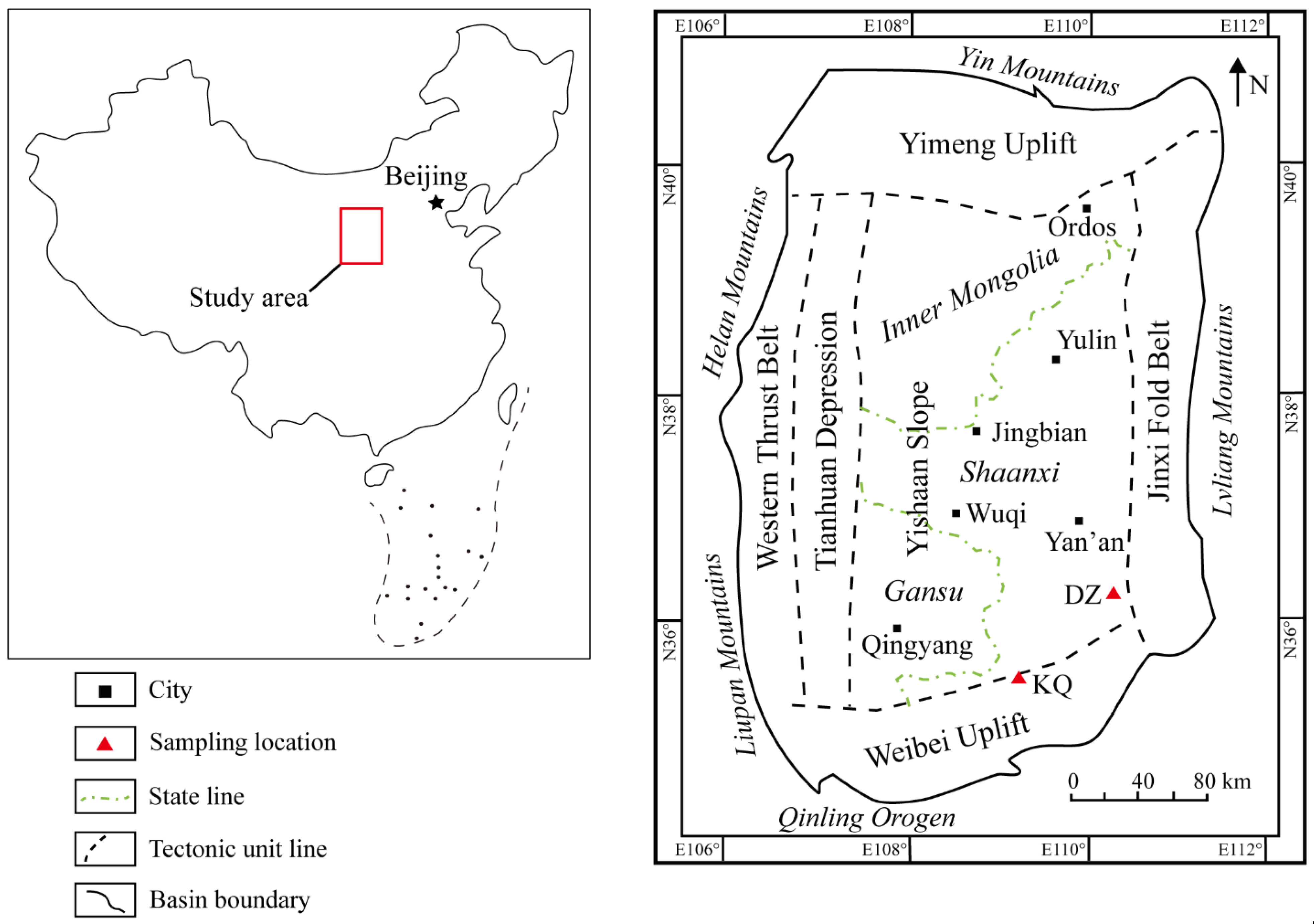
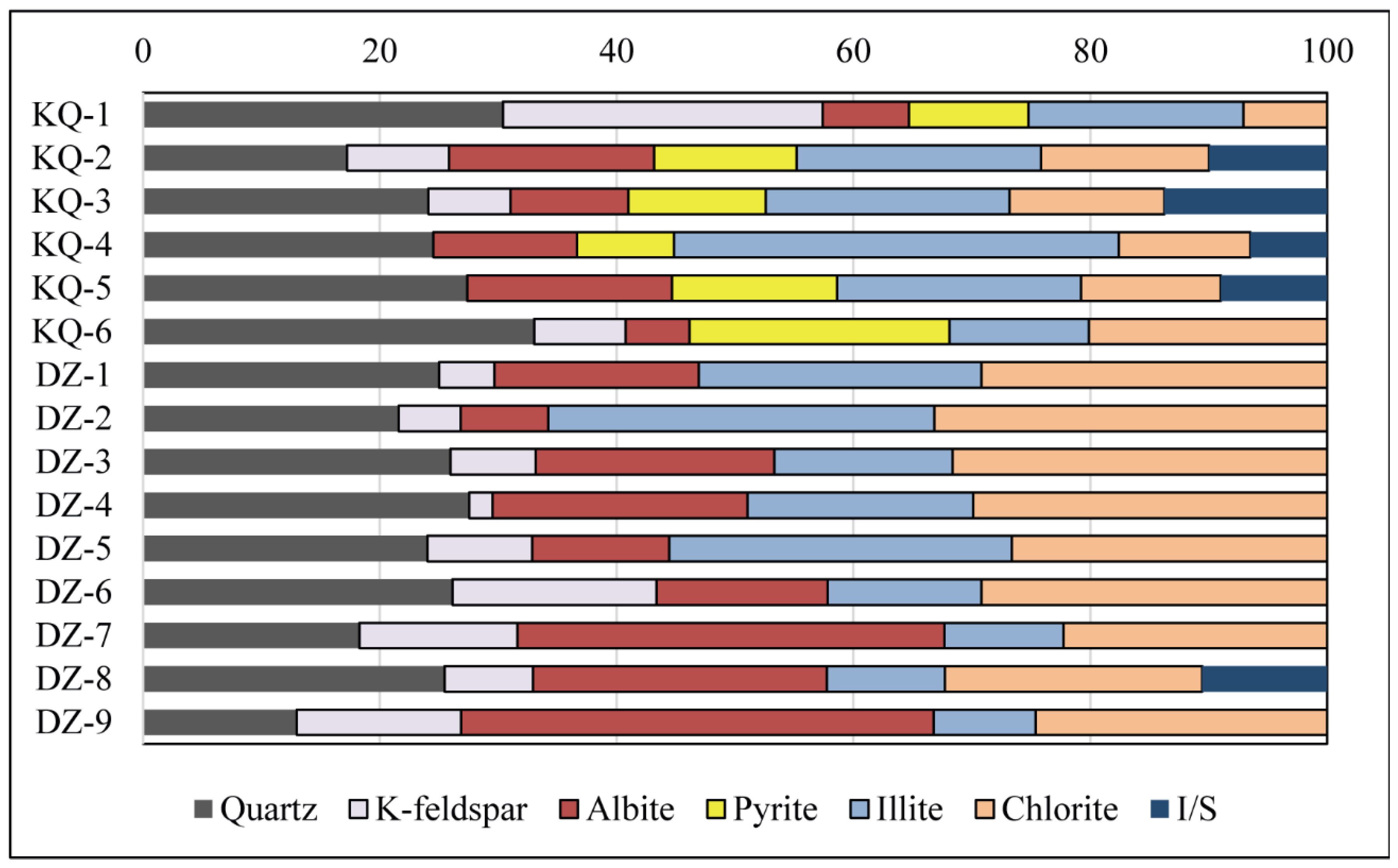
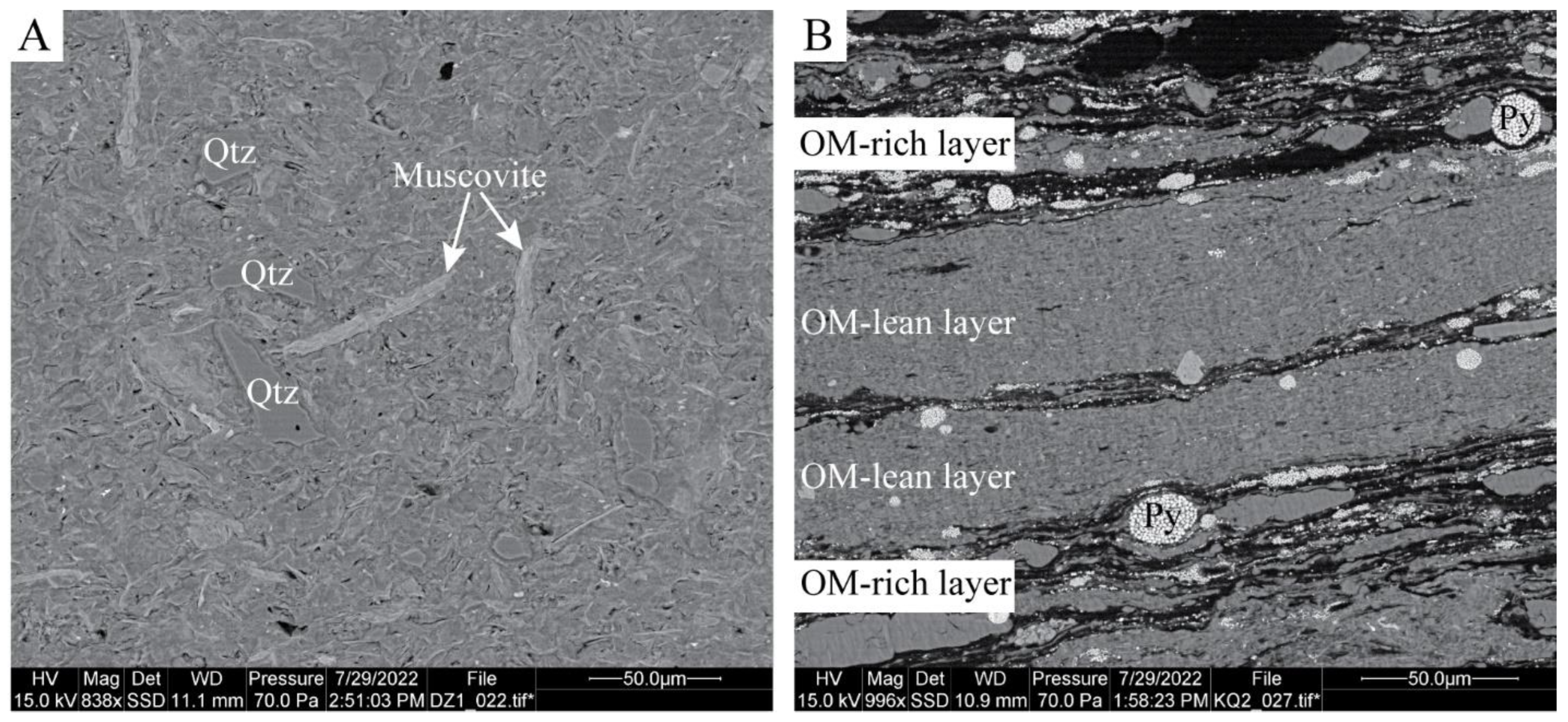
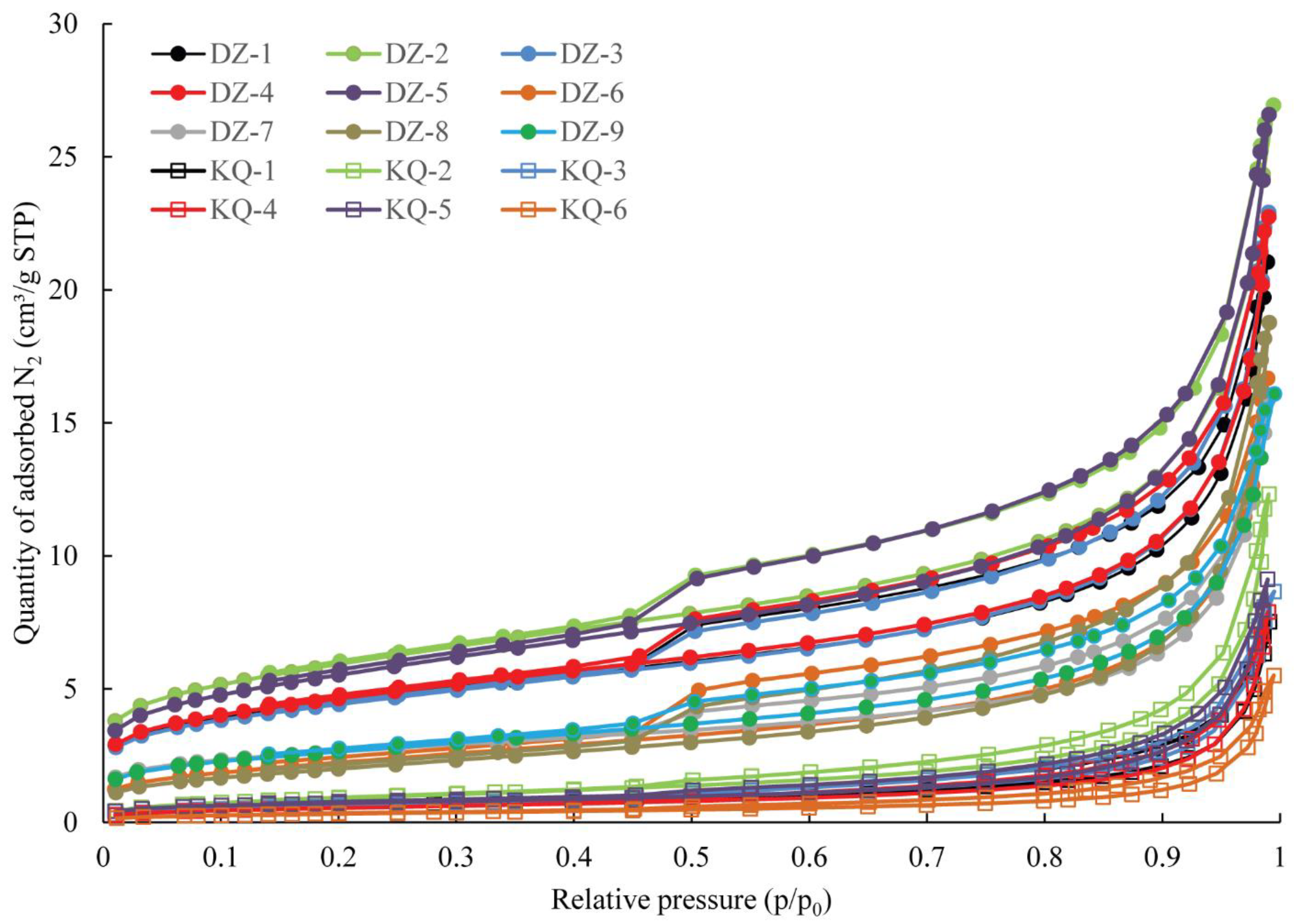


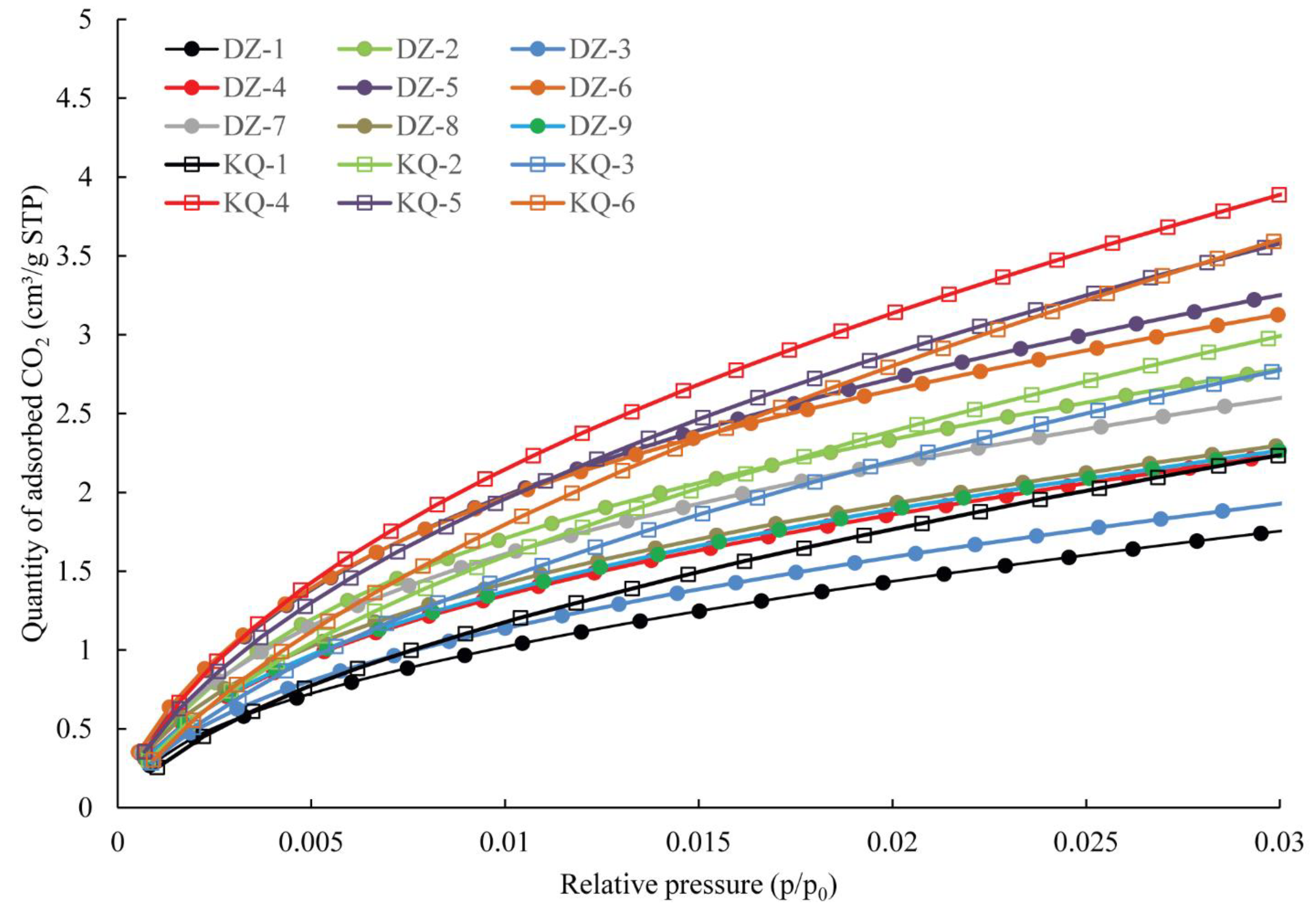
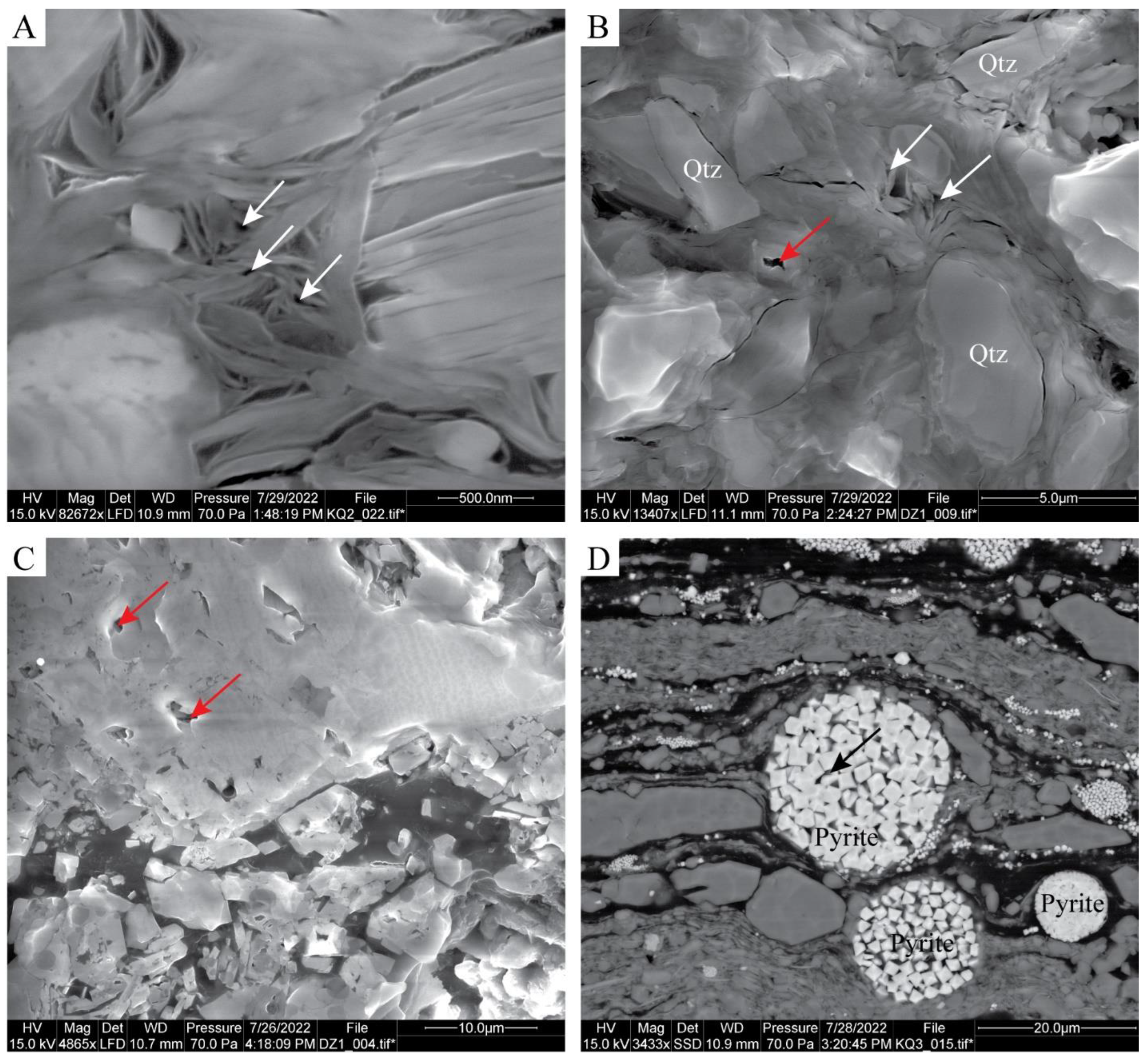
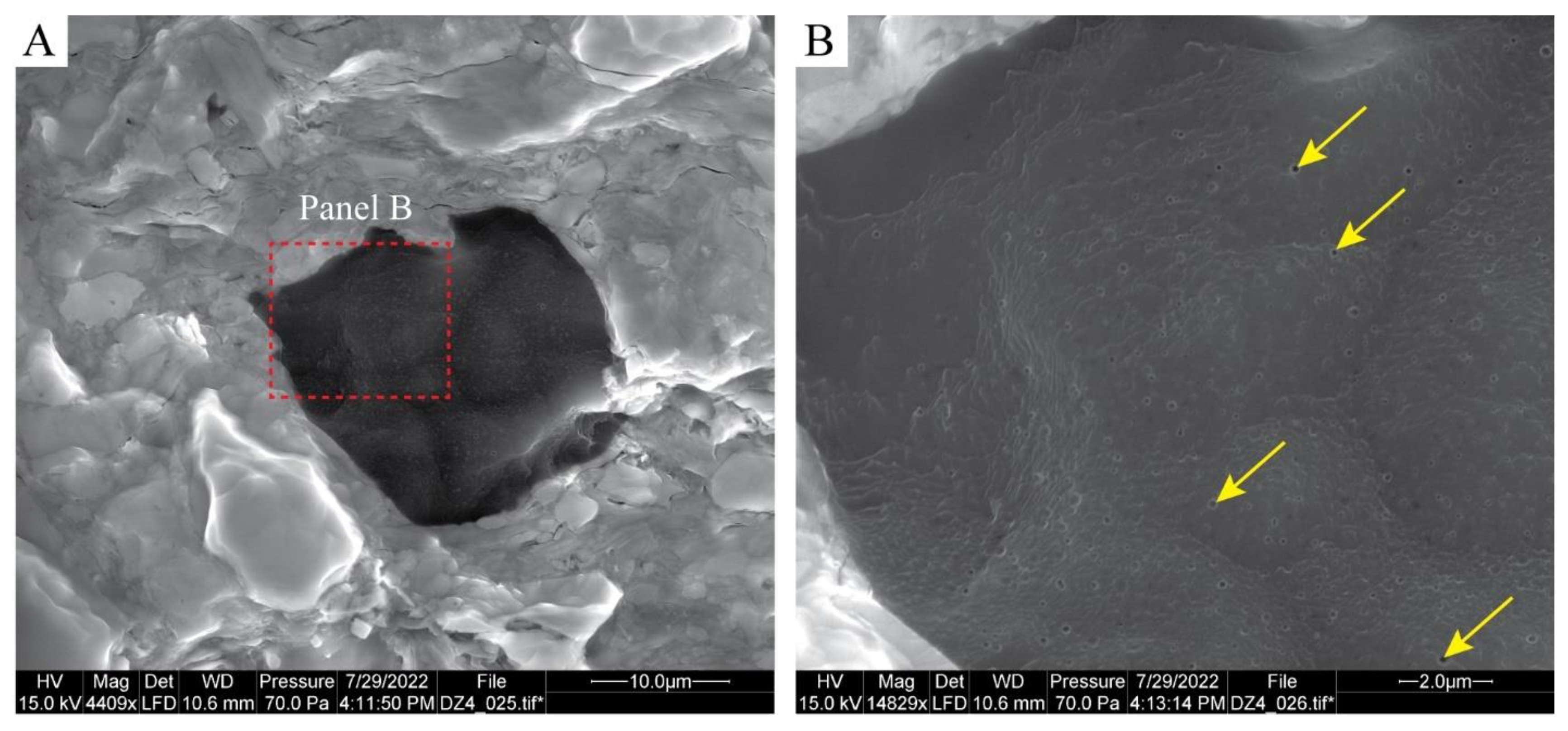
| Sample | Location | TOC (wt.%) | Ro (%) | n | Quartz | K-Feldspar | Albite | Pyrite | Illite | Chlorite | I/S | Total Clay |
|---|---|---|---|---|---|---|---|---|---|---|---|---|
| KQ-1 | Kuquan section, Yijun County, Tongchuan, Shaanxi | 12.48 | 0.69 | 25 | 30.4 | 27.0 | 7.3 | 10.1 | 18.1 | 7.1 | 0.0 | 25.2 |
| KQ-2 | 22.80 | 0.67 | 25 | 17.2 | 8.6 | 17.3 | 12.0 | 20.6 | 14.2 | 10.0 | 44.8 | |
| KQ-3 | 19.39 | 0.71 | 16 | 24.1 | 6.9 | 10.0 | 11.6 | 20.6 | 13.1 | 13.7 | 47.4 | |
| KQ-4 | 21.62 | 0.67 | 10 | 24.5 | 0.0 | 12.1 | 8.2 | 37.6 | 11.1 | 6.5 | 55.2 | |
| KQ-5 | 21.73 | 0.74 | 22 | 27.4 | 0.0 | 17.3 | 13.9 | 20.6 | 11.8 | 9.0 | 41.4 | |
| KQ-6 | 33.15 | 0.69 | 22 | 33.0 | 7.7 | 5.4 | 22.0 | 11.8 | 20.1 | 0.0 | 31.9 | |
| Average | 21.86 | 0.70 | 20 | 26.1 | 8.4 | 11.6 | 13.0 | 21.5 | 12.9 | 6.5 | 41.0 | |
| DZ-1 | Danzhou section, Yichuan County, Yan’an, Shaanxi | 0.31 | 0.72 | 26 | 25.0 | 4.7 | 17.3 | 0.0 | 23.9 | 29.2 | 0.0 | 53.1 |
| DZ-2 | 0.30 | 0.72 | 23 | 21.6 | 5.2 | 7.4 | 0.0 | 32.6 | 33.2 | 0.0 | 65.8 | |
| DZ-3 | 0.30 | 0.71 | 27 | 26.0 | 7.2 | 20.1 | 0.0 | 15.1 | 31.6 | 0.0 | 46.7 | |
| DZ-4 | 0.55 | 0.70 | 27 | 27.5 | 2.0 | 21.5 | 0.0 | 19.1 | 29.9 | 0.0 | 49.0 | |
| DZ-5 | 0.72 | 0.71 | 22 | 24.0 | 8.8 | 11.6 | 0.0 | 28.9 | 26.6 | 0.0 | 55.6 | |
| DZ-6 | 1.76 | 0.68 | 21 | 26.1 | 17.2 | 14.5 | 0.0 | 13.0 | 29.2 | 0.0 | 42.2 | |
| DZ-7 | 3.70 | 0.70 | 27 | 18.3 | 13.3 | 36.1 | 0.0 | 10.1 | 22.3 | 0.0 | 32.3 | |
| DZ-8 | 2.14 | 0.71 | 23 | 25.5 | 7.5 | 24.8 | 0.0 | 10.0 | 21.7 | 10.5 | 42.3 | |
| DZ-9 | 3.54 | 0.71 | 24 | 13.0 | 13.9 | 39.9 | 0.0 | 8.6 | 24.6 | 0.0 | 33.3 | |
| Average | 1.48 | 0.71 | 24 | 23.0 | 8.9 | 21.5 | 0.0 | 17.9 | 27.6 | 1.2 | 46.7 |
| Sample | TOC (wt.%) | BET SSA (m2/g) | BJH Pore Volume (cm3/g) | D-R Micropore Surface Area (m2/g) | D-A Micropore Volume (cm3/g) |
|---|---|---|---|---|---|
| KQ-1 | 12.48 | 2.08 | 0.0116 | 21.05 | 0.0149 |
| KQ-2 | 22.80 | 3.36 | 0.0191 | 27.48 | 0.0209 |
| KQ-3 | 19.39 | 2.33 | 0.0134 | 25.97 | 0.0200 |
| KQ-4 | 21.62 | 1.94 | 0.0122 | 35.64 | 0.0196 |
| KQ-5 | 21.73 | 2.45 | 0.0142 | 31.95 | 0.0228 |
| KQ-6 | 33.15 | 1.17 | 0.0085 | 36.73 | 0.0261 |
| Average | 21.86 | 2.22 | 0.0132 | 29.80 | 0.0207 |
| DZ-1 | 0.31 | 15.99 | 0.0320 | 0.0114 | 14.08 |
| DZ-2 | 0.30 | 20.86 | 0.0402 | 0.0102 | 23.93 |
| DZ-3 | 0.30 | 15.63 | 0.0351 | 0.0107 | 15.49 |
| DZ-4 | 0.55 | 16.38 | 0.0342 | 0.0106 | 18.04 |
| DZ-5 | 0.72 | 19.56 | 0.0403 | 0.0132 | 27.42 |
| DZ-6 | 1.76 | 8.07 | 0.0262 | 0.0117 | 25.90 |
| DZ-7 | 3.70 | 9.23 | 0.0240 | 0.0110 | 20.70 |
| DZ-8 | 2.14 | 7.31 | 0.0294 | 0.0105 | 18.11 |
| DZ-9 | 3.54 | 9.38 | 0.0248 | 0.0101 | 18.64 |
| Average | 1.48 | 13.60 | 0.0318 | 0.0110 | 20.26 |
Publisher’s Note: MDPI stays neutral with regard to jurisdictional claims in published maps and institutional affiliations. |
© 2022 by the authors. Licensee MDPI, Basel, Switzerland. This article is an open access article distributed under the terms and conditions of the Creative Commons Attribution (CC BY) license (https://creativecommons.org/licenses/by/4.0/).
Share and Cite
Liu, B.; Teng, J.; Li, C.; Li, B.; Bie, S.; Wang, Y. The Control of Shale Composition on the Pore Structure Characteristics of Lacustrine Shales: A Case Study of the Chang 7 Member of the Triassic Yanchang Formation, Ordos Basin, North China. Energies 2022, 15, 8353. https://doi.org/10.3390/en15228353
Liu B, Teng J, Li C, Li B, Bie S, Wang Y. The Control of Shale Composition on the Pore Structure Characteristics of Lacustrine Shales: A Case Study of the Chang 7 Member of the Triassic Yanchang Formation, Ordos Basin, North China. Energies. 2022; 15(22):8353. https://doi.org/10.3390/en15228353
Chicago/Turabian StyleLiu, Bei, Juan Teng, Chen Li, Baoqing Li, Shizhen Bie, and Yinlong Wang. 2022. "The Control of Shale Composition on the Pore Structure Characteristics of Lacustrine Shales: A Case Study of the Chang 7 Member of the Triassic Yanchang Formation, Ordos Basin, North China" Energies 15, no. 22: 8353. https://doi.org/10.3390/en15228353
APA StyleLiu, B., Teng, J., Li, C., Li, B., Bie, S., & Wang, Y. (2022). The Control of Shale Composition on the Pore Structure Characteristics of Lacustrine Shales: A Case Study of the Chang 7 Member of the Triassic Yanchang Formation, Ordos Basin, North China. Energies, 15(22), 8353. https://doi.org/10.3390/en15228353






